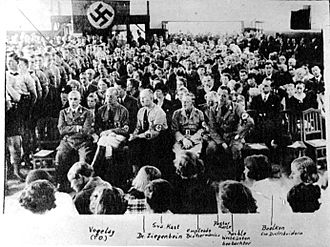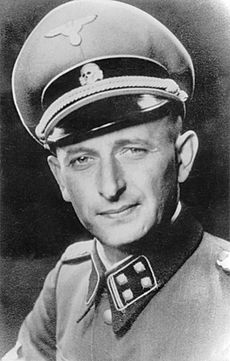Nazism in the Americas facts for kids

Nazism is a political idea that started in Germany in the 1930s. It also spread to North and South America and still exists today. Some people of German heritage in the Americas supported these ideas. They wanted to bring the spirit of Nazism from Europe to their new homes.
Before and during World War II, Nazi groups in America did many things. They showed Nazi signs, took over newspapers, and spread messages that supported Nazism. They also tried to join other groups to spread their ideas. People reacted to these groups in different ways. Some supported them, while others strongly fought against them. For example, the first groups against Nazis in the United States were formed, like the Non-Sectarian Anti-Nazi League.
Contents
United States
Before World War II
Adolf Hitler became the leader of Germany on January 30, 1933. For many years, some German-Americans tried to create groups that supported Nazis in the U.S. These groups often used swastika symbols and wore uniforms. However, most German-Americans did not support these groups.
In May 1933, a man named Heinz Spanknöbel was given permission by Rudolf Hess, a top Nazi leader, to start an official Nazi Party branch in America. This group was called the Friends of New Germany. The Nazi Party in Germany called it the National Socialist German Workers' Party of the U.S.A. This group was based in New York City and also had a strong presence in Chicago. It received support from the German consul (a government official) in New York.
Spanknöbel's group openly supported Nazis. Its members even stormed a German-language newspaper, New Yorker Staats-Zeitung. They demanded that the newspaper publish articles that supported Nazi ideas. Spanknöbel's leadership did not last long. He was sent out of the country in October 1933 because he had not registered as a foreign agent.
During World War II
The Friends of New Germany group ended in the 1930s. A new group called the German American Bund was formed in 1935. It was led by Fritz Kuhn. This group lasted until America officially joined World War II in 1941. The Bund wanted America to be united under the rule of people of German background. They followed Nazi ideas. They said that communism was their main enemy. They also showed anti-Jewish attitudes.
The Bund created its own youth division, similar to the Hitler Youth in Germany. Young members took German lessons and learned how to salute the swastika. They also learned to sing Nazi songs like the 'Horst Wessel Lied'. When World War II started, the Bund continued to praise Hitler and his actions in Europe. After Germany invaded Poland in 1939, Bund leaders said America should stay neutral. They also showed support for Germany's war efforts. The Bund believed that supporting Germany was not disloyal to the United States. They said German-Americans would "continue to fight for a Gentile America free of all atheistic Jewish Marxist elements."
After many disagreements within the group, the Bund's leaders decided to break up the party. This happened the day after the bombing of Pearl Harbor. On December 11, 1941, the United States officially declared war on the Axis powers. Bund offices were searched by government agents. The agents took all their records and arrested 76 Bund leaders.
After World War II
After World War II, many Nazi war criminals came to the United States from Eastern Europe. The Office of Special Investigations estimated about ten thousand of them entered the country. Some came through a project called Operation Paperclip. This project brought German scientists and engineers to the U.S. Most Nazi helpers entered the United States using laws like the 1948 and 1950 Displaced Persons Acts. They also used the Refugee Relief Act of 1953.
People who supported these laws were not very worried about Nazi war criminals entering the U.S. They were more focused on stopping known communists from coming in. This change in focus happened because of the Cold War after World War II. During this time, the United States was more concerned about fighting Soviet communism than Nazism.
In the 1950s, the Immigration and Naturalization Service investigated some suspected Nazi war criminals. But no official trials came from these investigations. In the 1960s, the topic of the Holocaust and Nazi helpers living in the U.S. became a bigger public discussion. This was due to the trial of Adolf Eichmann and articles by Charles R. Allen. The government then started to focus on finding Nazi war criminals in the country.
Public awareness of the Holocaust and remaining Nazi war criminals grew in the 1970s. Many cases were in the news. The case of Hermine Braunsteiner-Ryan received a lot of media attention. She was the first Nazi war criminal sent back from the United States. This case made the Immigration and Naturalization Service look for more Nazi helpers. By the late 1970s, the U.S. government formed the Office of Special Investigations. This office was specifically for finding Nazi war criminals in the United States.
During this time, a new idea called Neo-Nazism appeared. Neo-Nazis want to bring back and use Nazi ideas. They try to spread hatred and white supremacy. They attack people from different races and backgrounds. They also want to create a fascist state. Neo-Nazism is a worldwide idea. It has groups in many countries and international connections. It uses parts of Nazi beliefs, such as:
- ultranationalism (extreme loyalty to one's own nation)
- racism
- xenophobia (fear of foreigners)
- ableism (discrimination against disabled people)
- homophobia (fear or hatred of gay people)
- anti-Romanyism (hatred of Romani people)
- antisemitism (hatred of Jewish people)
- anti-communism
- wanting to create a Fourth Reich (a new German empire).
Neo-Nazi groups often deny that the Holocaust happened.
In the United States, groups like the American Nazi Party, the National Alliance, and White Aryan Resistance were formed in the second half of the 20th century. The National Alliance was started in the 1970s by William Luther Pierce. He wrote a book called The Turner Diaries. This group was the largest and most active neo-Nazi group in the U.S. in the 1990s.
21st Century
According to the Southern Poverty Law Center, the National Alliance lost most of its members by 2020. However, it is still present in the U.S. Other groups, like Atomwaffen Division, have taken its place. American Neo-Nazi groups have become more spread out and use online social networks. They often focus on terrorism.
South America
Before World War II
The National Socialist Movement of Chile (MNSCH) formed in 1932. It was founded by Carlos Keller Rueff and Jorge Gonzalez von Marees. Both had German backgrounds. The members were called Nacistas. The party had a pyramid-like structure with a leader called a Jefe. It also had special groups called TNA.
Unlike European Nazism, this party did not focus much on racial purity. Racial purity was not important in Chile and was seen as against the country's traditions. However, the MNSCH acted like many other fascist groups. It focused on:
- totalitarianism (a system where the government has total control)
- military values
- elitism (belief that a small group of people are superior)
- hierarchy (a system of ranking people)
- discipline
- the need for action.
The MNSCH also believed that individuals should serve the nation. They thought the nation was a higher organism needed for survival. The party wanted a totalitarian, unified order, similar to European Nazism. They disliked elections and said they were against democracy, liberalism, Marxism, conservatism, oligarchy, and imperialism.
During World War II
Some South American countries were against the Axis powers and Nazism in Europe. This was especially true after the bombing of Pearl Harbor in 1941. Other countries believed that continuing trade with both sides of the war would be good for them. German, Italian, and Spanish influences were strong in Argentina. This was because many immigrants from these countries lived there.
Fascist ideas spread in politics and the military, especially after the Revolution of '43. This trend continued during Juan Perón's time as president. It eventually led to over 40 years of military rule. In Chile, there was opposition to the German community because of the 1938 Seguro Obrero massacre. The United States used radio broadcasts and movies during the war. This was to create and spread anti-fascist messages across Latin America.
After World War II

After World War II ended, many Nazis and other fascists escaped to South America. They used secret routes called ratlines. Many of these routes were supported by the Catholic Church. The first efforts to smuggle Nazis and fascists began in 1946. Two Argentinian bishops worked with a French cardinal to bring French war criminals into Argentina. Under the orders of Argentine president Juan Perón, many European war criminals were brought into the country. They were given citizenship and jobs.
See also
 In Spanish: Fascismo en América para niños
In Spanish: Fascismo en América para niños





